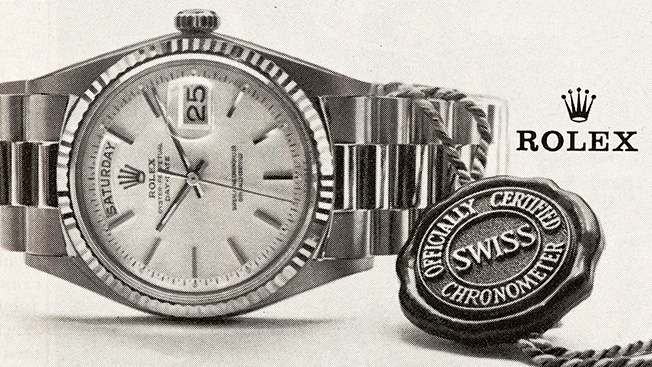
If there’s a branding equivalent of reaching nirvana, Rolex has done it. The 108-year-old brand is so famous, so coveted, it’s virtually synonymous with the luxury watch category, if not success itself.
Hyperbole? Permit us this: Rolex’s Oyster model—introduced in 1926 as the world’s first waterproof watch—has graced the wrists of everyone from Winston Churchill to Che Guevara to Eminem. Ian Fleming put a Rolex Submariner on the wrist of a character named James Bond, and an early Submariner 5510 fetched $98,500 at a Christie’s auction a few years back. Fashion trends come and go, but Rolex’s clean, utilitarian designs have outlasted all. Rolex’s precision movements can’t print money—or maybe they do. The brand is now worth more than $6.5 billion.
Crossing the divide from rarified luxe brand to global icon is a rare and fascinating process to study—or in this case, watch. That metamorphosis is on full view in these ads. The copy in the 42-year-old ad at right comes in at 446 words (caption excluded)—a lot of jargon, even for 1971. But according to Edward Faber, founder of New York’s Aaron Faber Gallery and author of American Wristwatches: Five Decades of Style and Design, there was a reason Rolex told this Tolkien-length tale of the 162 steps involved in making a watch. It had to. “Prior to the 1960s, Rolexes were only sold in the narrow market of British-flagged territories, so this was the first decade of them establishing a global brand,” Faber said. “They were appealing to the sense of craftsmanship, quality and integrity, giving the whole story line.”
And did they ever. Wealthy Americans whose tastes hovered above Timex proved to be the perfect audience for Rolex’s message of hand craftsmanship. Not many could afford a $1,250 watch in 1971, but those who did, bought. Faber estimates that Rolex turned out somewhere around a mere 10,000 watches that year, a function of the slowness of hand assembly. Today, the brand produces as many watches every five days, a function of computerized machinery. Rolex has become the largest luxury watch brand on the planet.
It follows, then, that the marketing department has reached the point where it can pretty much leave things on autopilot—which is clearly what the 2013 ad does. Why fuss with verbiage when you can just run the famous brand name with a pretty picture? As Faber said: “They believe they’ve penetrated what markets they can, so they’re no longer educating the public about the brand.”
The ad is clever in its simplicity, but Faber doesn’t consider it to be clever marketing. By losing all the copy, Rolex is also missing out on the chance to extol its standards, craftsmanship, 108 years of history—the very things that made it an iconic watch in the first place. “Sure, nobody wants to read text anymore, but they’ve also abandoned the heritage factor,” he said. “It’s ballsy of Rolex to do nothing, and I’m surprised. It seems more important to sell the logo than sell the quality.”
It is, if nothing else, a sign of the times.
